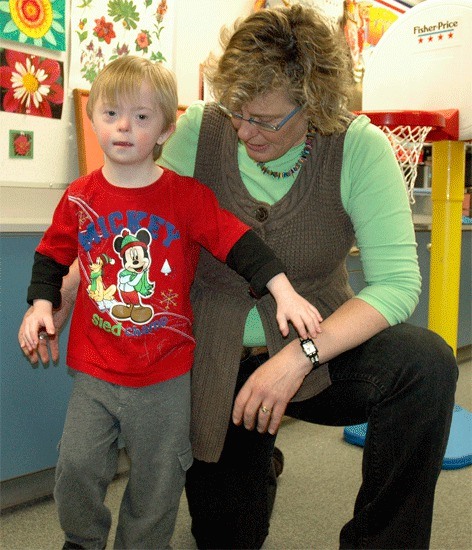By JOE HUNT
Special to the News-Times
When a young student can’t form written letters properly or write legibly, there is often an underlying cause that can be difficult to spot and even harder to fix. This is when occupational therapists and physical therapists get involved in the lives of students.
Oak Harbor’s occupational therapists, Kami Bible and Walter Gruenwald, are used to such puzzles.
They start with a premise: Despite the teacher’s best efforts, the handwriting fails to improve. Why?
Do these children have difficulty hearing or processing the information? Is there a visual problem? When they hold something in their fingers, such as a pencil, do they have the normal motor controls to manipulate the object? Can they sit in a chair long enough to focus on their work?
“If you don’t have awareness of where your body is in space, what you get is really bad handwriting,” Gruenwald said.
Teachers are the first to notice a problem and when normal classroom techniques fail, they request an evaluation. It takes both experience and intuition to isolate the problems and then figure out how to best work with those kids, Bible said.
“It’s taking little pieces of the puzzle and putting it together to see what works,” she said. “Some of the problem might be kids being kids. It’s a very subjective area.”
The acronyms OT (occupational therapy) and PT (physical therapy) are usually seen together. They are separate disciplines, but the overall goal of occupational and physical therapists is the same: to help kids better control their own bodies so they can learn. They sometimes even share the same work rooms.
While occupational therapy focuses on fine motor skills, physical therapy works on gross motor skills, such as walking or jumping or even strengthening the neck muscles required to hold one’s head off the desk.
“Kids need to have good core muscle strength, body awareness and coordination to be successful in school,” said Monica Kidder, the district’s lone physical therapist.
For example, therapy helps kids gain the strength and coordination to sit upright and maintain attention in the classroom, carry their lunch trays, and play with peers at recess and in the gym. The two disciplines often mesh to improve the learning and the lives of kids.
“The lines do run together frequently,” Kidder said. “Kids need good strength and they need those fine skills. After all, their bodies develop all together.”
“Kids who have trouble with fine motor activities, also need to work on gross motor skills,” Gruenwald said. “Typically, it all goes together.”
Occupational and physical therapists work in a world of games, swings and toys. Their work rooms resemble romper rooms, filled with tools to keep kids active to stimulate specific muscles or practice hand-to-eye coordination. Kids usually look forward to the sessions, with each student excited to do a favorite activity. But, first things first. Bible makes her students do the hard work before they get a chance to let loose and play at the end of the session.
She recently discovered that the iPad is a great writing tool for some kids. She had two girls who both refused to even attempt writing. “But they loved the iPad,” Bible said. “The first time I had them write on this it was just amazing.” Both girls used a stylus to write out their names on the touch screen.
The iPad helps students practice their hand-eye coordination and has become a regular tool for improving handwriting.
To be an OT or PT means highly active days. Although they are aided by occupational therapy assistants Pam Merrill and Kristine McInvaille, the work load is heavy. Each occupational therapist has 70 students to work with; they schedule the day so each student has 30 minutes of therapy each week. The physical therapist meets with 40 students each week.
For most students who are physically capable, the therapy often turns into a structured playroom of activity. To the kids, it’s having fun. To the therapists, it is constant one-on-one activity, working on specific issues, while keeping up with highly-energized kids.
“By the end of the day, I’m usually wiped out,” Gruenwald said.
Joe Hunt is communications director for the Oak Harbor School District.



